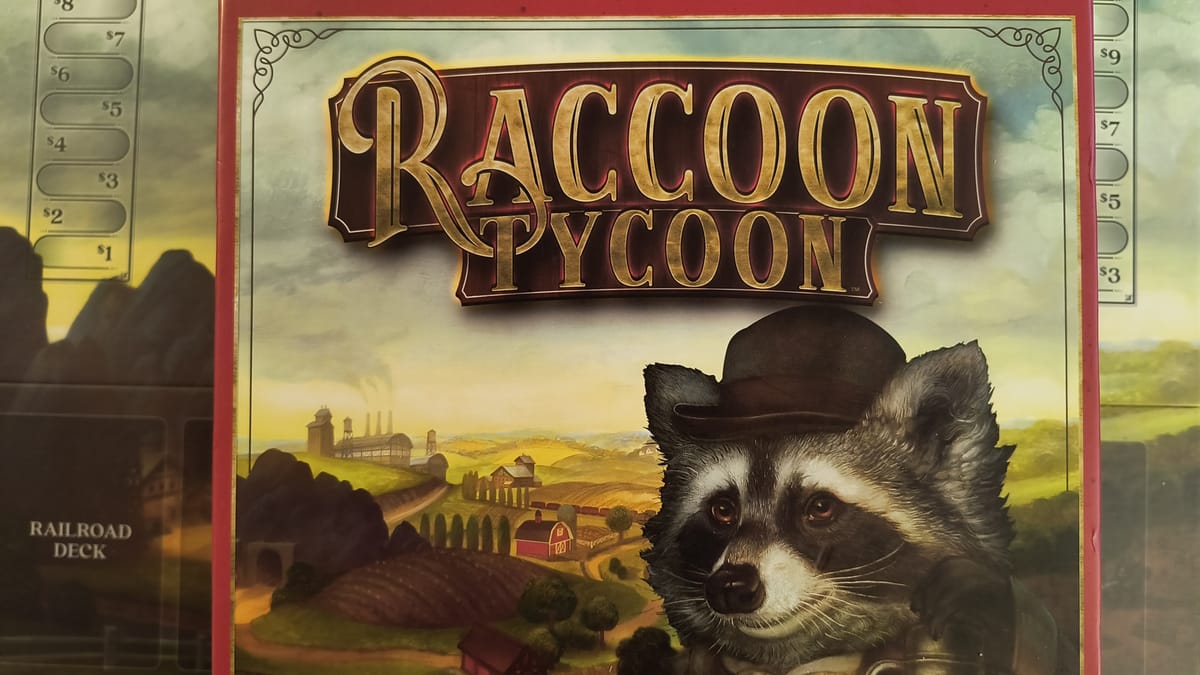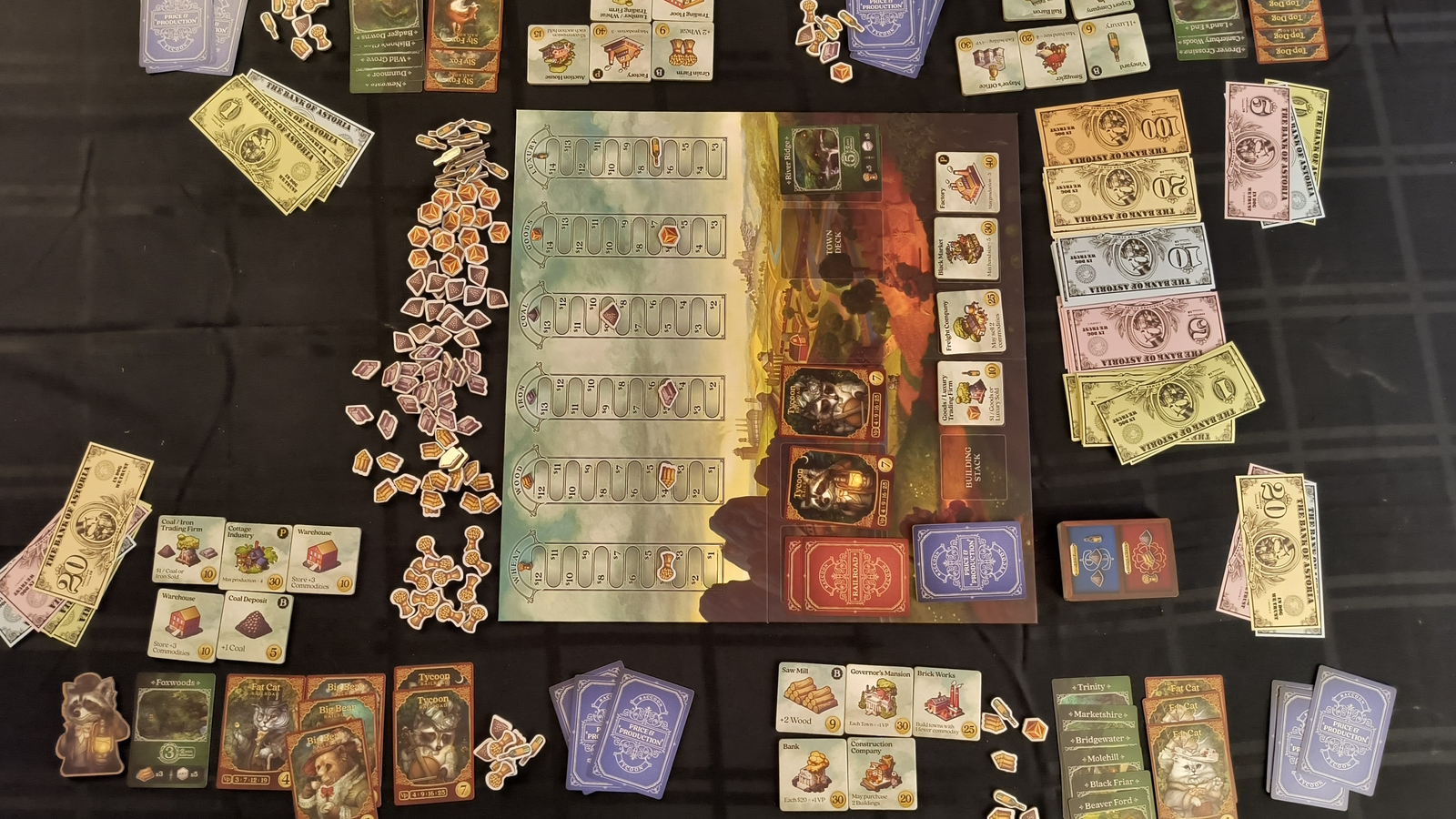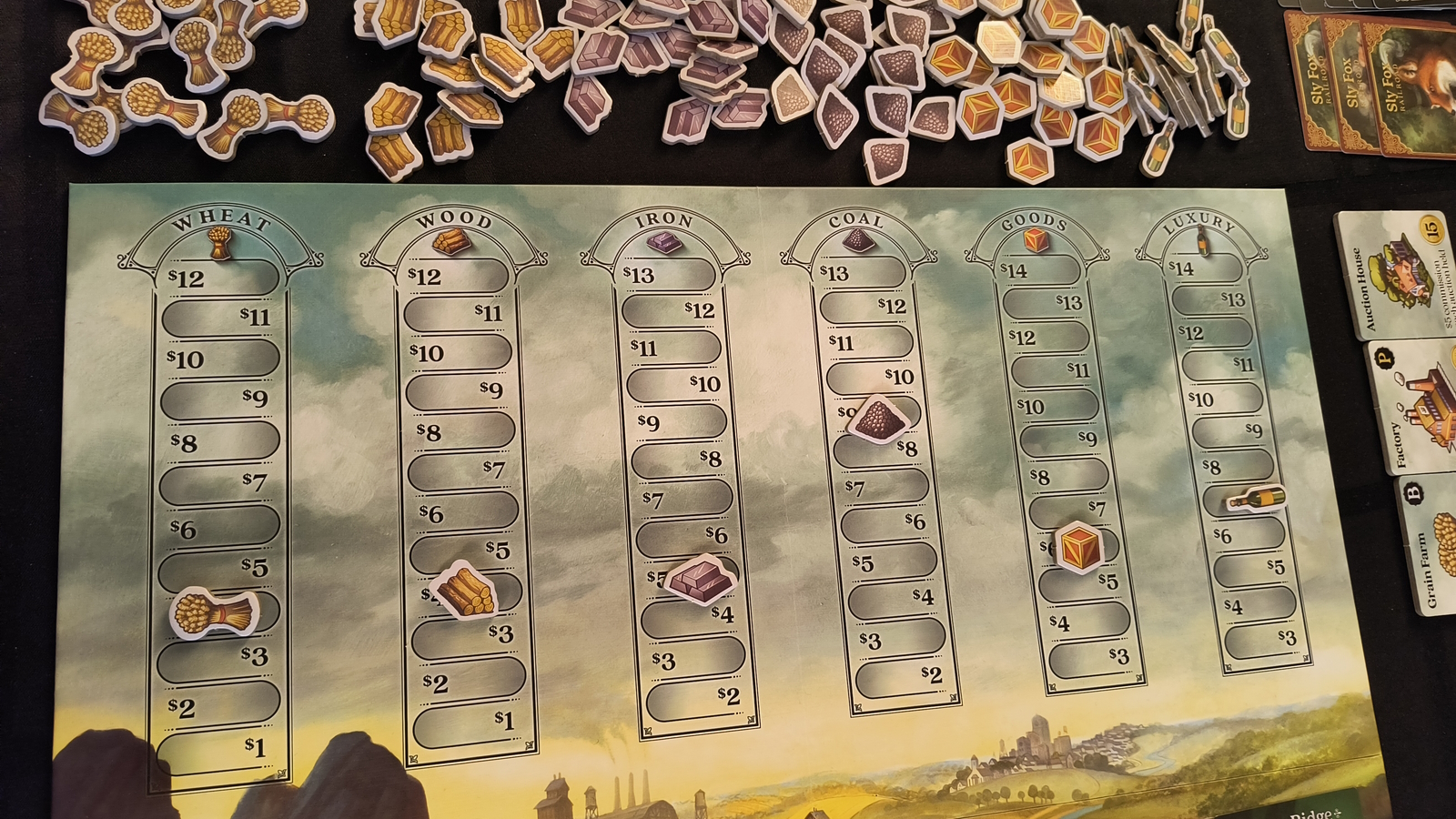
The industrial revolution has begun in the country of Astoria, a land of animal-folk. The railroad boom has begun, and you are an industrialist with the task of connecting towns with railroads and using a resource market to fund the process.
Raccoon Tycoon by Forbidden Games is an economic game for 2 to 5 players with a unique resource market at its core. Each turn, a player may do one of five things. The first option is to produce resources, which use production cards. Production cards have icons along the top, which increase the sell price of goods, and goods along the bottom, which gives the player up to three resources.
The second action you can take is to sell all of one resource, which nets you cash for its current value for each resource sold, and reduces the value afterwards by however many resources were sold. This leads to a boom and bust economy where you want to sell while the selling is good, but you need to be aware of your opponents looking to do the same.
Another action you can take is to buy buildings. There is a bunch of building tiles at the bottom of the game board which you can buy for money. These tiles are very powerful, but very expensive. They can do a number of things, like adding specific resources to every production card, allowing you to select more than three resources from a single production card, or giving you money every time another player takes certain actions.
The fourth option is to supply a town. When you supply a town, you need to provide it with several of a specific resource, or a lot more of any kind of resource. Towns net you points, but give you even more points if you can provide them with railroads.
That leads to the last action available: auctioning a railroad. You can choose from two available railroads and start an auction. Players go around the table, bidding higher and higher amounts for the railroad in question. If the initiating player doesn’t win the bid they get another action. Railroads, in addition to providing a minor point bonus for each town you can match it up to, also provide set bonuses with other railroads from the same company. Railroads provide the most points in the game, but also have the highest risk thanks to the chance of other players winning auctions you start, effectively giving them a “free” action.
And that just about covers how the game is played. Players will keep taking actions right up until either the railroad or town deck runs out of cards. The simplicity is definitely a nice change of pace, especially for economic games. Players can choose to focus on specific strategies to win, such as producing cheap resources to purchase a bunch of towns, or producing expensive resources to get money and buy railroads.
The quality of components of this game is impressive. Each resource and building tile is printed on chonky cardboard that feels like it will last, and the cards from all three decks are a joy to handle. The game has a big stack of paper money that works thematically, and is of finer stock than, say, Monopoly. While the game costs $40 MSRP, it has the quality of a more expensive game. The only oddity in its build quality is the box insert. For some reason, the card slots are very shallow, only fitting 2 of the 3 decks that come with the game. The third deck, presumably, sits alongside the tiles in a weird squeeze.
This gets into the other issues with the game. First and foremost, the game balance is a bit odd. Production cards are skewed towards expensive products being more effective. As an example, lower-end resources are less likely to increase in price, despite those resources being nearly equal in chance to be produced, and those resources being worth less naturally. Higher tier goods have a slightly lower chance to be produced, but nearly every card increases the cost of one or both of the high cost resources.
Another issue is the power of the dollar in this game. A player can become unbeatably wealthy in one turn through a lucky (or shrewd) sale, and then that wealth can carry them through much of the game. A wealthy player can take every auction offered for railroads, which provide the largest share of points. When mixed with the problem with the production card imbalance, you can wind up with a single player getting one of the early buildings that produce goods or luxuries, and winning off the back of their first building purchase.
My final gripe is that this game has a much better, more fleshed out sequel made by the same folks. Lizard Wizard uses the same basic economic mechanic, but provides more things for players to do, and more strategies for victory, as well as a spell system that makes the entire game shift on its head on a regular basis. This leads to Lizard Wizard being a much less frustrating experience, as it means there’s always something you can do, even if someone has a whole lot of money.
That being said, Raccoon Tycoon came first. Judged from that light, I feel like there are just not a lot of paths to victory. There is very little feel of intelligent politicking or smart plans, as any plan you make can be made irrelevant by accident by the time your turn next comes around.
Raccoon Tycoon
Good
A barebones economic game experience. Some strange choices in the balance of resources as well as some strategies being very much overpowered leads to things becoming one sided by the middle of the game. I can definitely see this as being a simple to teach gateway into much better games. However, a sequel that blows it out of the water makes it a hard sell in my opinion.
Pros
- Exceptional quality components
- Unique resource market system at the core
- Lightweight economic game
Cons
- Not a lot of things to do with the economy
- Resources are weirdly imbalanced
- Dominant players become oppressive during auctions.
- The sequel to this game makes it hard to suggest instead.
